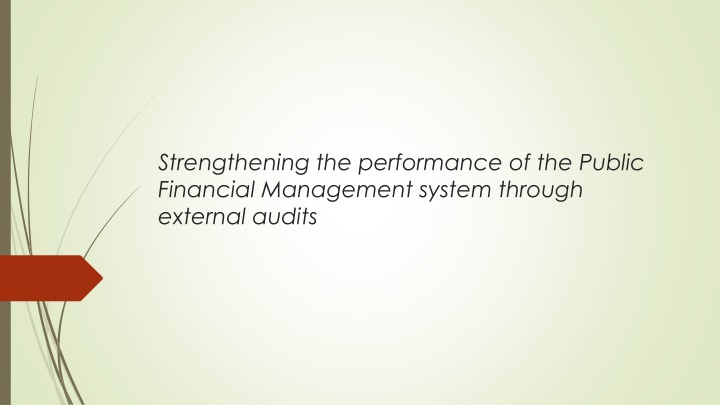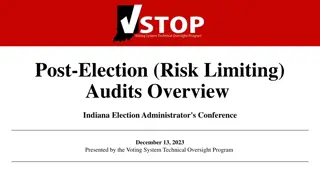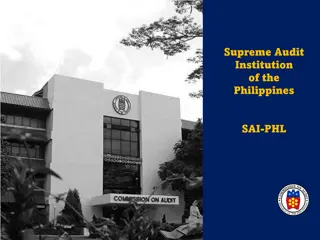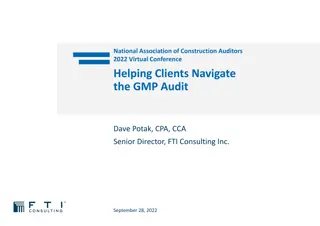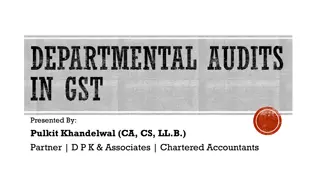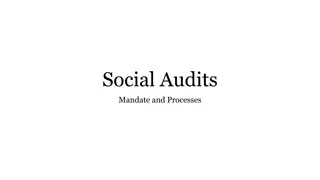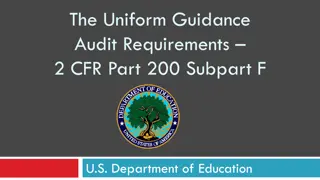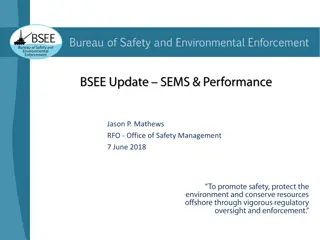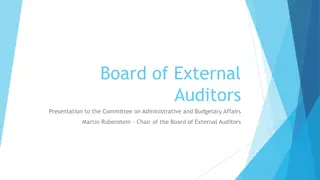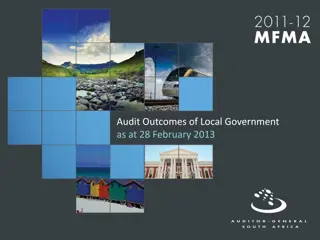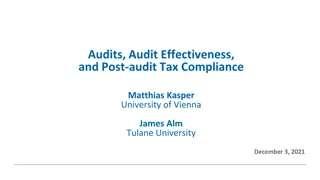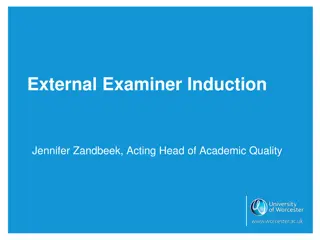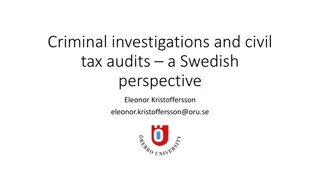Enhancing Public Financial Management Through External Audits
Strengthen the performance of the Public Financial Management system by utilizing external audits and international standards. Main entry points for SAIs, diagnostic tools, and challenges in assessing PFM are discussed. Learn how to effectively use diagnostic tools to complement audit work and address internal and external challenges faced by SAIs.
Download Presentation

Please find below an Image/Link to download the presentation.
The content on the website is provided AS IS for your information and personal use only. It may not be sold, licensed, or shared on other websites without obtaining consent from the author.If you encounter any issues during the download, it is possible that the publisher has removed the file from their server.
You are allowed to download the files provided on this website for personal or commercial use, subject to the condition that they are used lawfully. All files are the property of their respective owners.
The content on the website is provided AS IS for your information and personal use only. It may not be sold, licensed, or shared on other websites without obtaining consent from the author.
E N D
Presentation Transcript
Strengthening the performance of the Public Financial Management system through external audits
Main entry points for SAIs to assess the performance of public financial management (PFM) processes and activities? Mandate to audit the PFM should be spelled out in the legal frameworks of the SAI The SAI should have a good understanding of the PFM cycle, processes and activities How are processes/activities selected by the SAI? Using the risk based audit approach. That is by risk profiling institutions into high, medium and low risk and selecting the high to medium risk institutions. Public interest Impact on the achievement of the objectives of the National Development Plans
International standards and diagnostic tools auditors can use to conduct thee audits International Standards Sustainable Development Goal (SDG) No. 16 Fiscal Transparency Code OECD principles of budgetary governance Global Initiative for Fiscal Transparency (GIFT) Diagonistic Tools Public Expenditure and Financial Accountability (PEFA) Public Financial Management Performance Measurement Framework Open Budget Survey (OBS) by IBP Fiscal Transparency Evaluation (IMF) OECD Budgetary Governance Reviews Boost Database by the World Bank Public Financial Management Reporting Framework developed by AFROSAI-E
How can these diagnostic tools be used in practice to support /complement audit work Auditors can use the diagnostic tools to get an overall picture of the PFM system E.g. the PEFA and external audits complement each other to get a better analysis of budget credibility to improve the performance of the budget process and PFM systems
The main challenges for SAIs to assess the performance of the PFM system: Internal challenges Lack of expertise on PFM issues Limited resources Siloed organisational structure and working methods Lack of customised assessment frameworks External process challenges Multiple (potentially conflicting objectives of the PFM system) e.g. expansive budgeting policy versus fiscal rules (can make it difficult for auditors to determine audit objectives) Inadequate internal controls Complexity of the system and audited entities plus a lack of synergies and collaboration among key stakeholders of the PFM system Limited access to information
How can challenges be addressed? Understand the SAI mandate Use and develop BIG Data analytics to support audits of the PFM system Cooperate with other SAIs on capacity development Select the area of PFM in greatest need of an audit Ensure the effectiveness of follow-up to audit recommendations
Benefits for auditing the performance of the PFM system and examples of positive impacts from audit work Benefits Improvement in the alignment of PFM processes to ensure the achievement of National Development Plans Ensures that the domesticated SDGs are factored in the budgeting processes and their implementation is monitored and reviewed Issuing of quality recommendations on PFM deficiencies as a result of addressing root causes of under performance of the entire budget cycle Positive impacts Proper utilisation of public funds and enhancement of the performance of the PFM system to achieve the SDGs Improvement in legislation, rules and regulations regarding the preparation and implementation of the national budgets such as the enactment of the National Budgeting Act Improvement in accounting and reporting systems by implementing Integrated Financial Management Information System (IFMIS) to enable timely production of financial reports and monitor the execution of budgets Rolling out of the Single Treasury Account to enable Government have control of its cash management
Key recommendations or action points to advance SAI work in area of PFM: Mandate to be clearly provided in the SAI legal frameworks Legislations (e.g. Public Finance Management Act) should be strengthened to provide for sanctions for abrogation of PFM processes and rules To continue lobbying the Governments to implement and fully roll out the financial information management systems to all levels of the Government (Central and Local Government)
